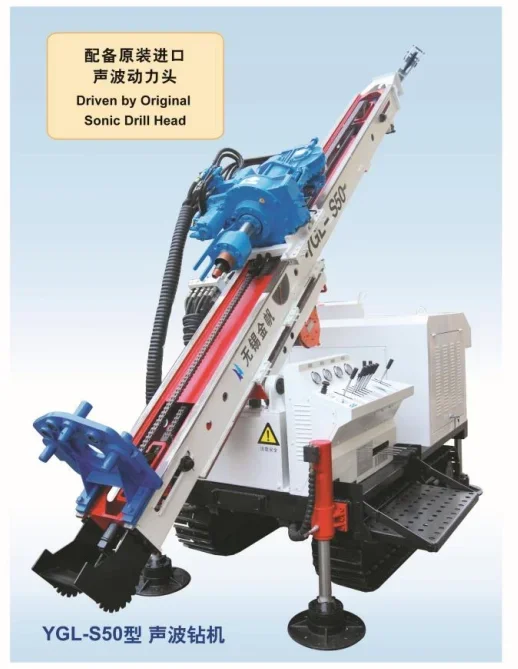In the field of drilling technology, sonic drilling rigs are the first choice. With their unique features and advanced sonic drilling technology, these drilling rigs have found widespread industrial applications. In this blog, we’ll explore the various industries that benefit from sonic drills, highlighting their versatility and efficiency in meeting a variety of challenges.
I. Understanding Sonic Drilling
Before delving into the industrial applications, it is essential to grasp the fundamentals of sonic drilling. Unlike conventional drilling methods that rely solely on rotation and percussion, sonic drilling employs high-frequency vibrations to overcome challenging subsurface conditions.
A. Sonic Drilling Technique:
Vibrations: Sonic drilling rigs generate high-frequency vibrations through a sonic head that is attached to the drill string. These vibrations reduce friction between the drill string and the surrounding formation, allowing for faster and more efficient drilling.
Core Sample Extraction: As the sonic head vibrates, the drill string and core barrel penetrate the subsurface. The vibrations facilitate the extraction of intact core samples, minimizing sample disturbance and preserving their geological integrity.

II. Industrial Applications of Sonic Drilling Rigs
Sonic drilling rigs have proven to be versatile tools across various industries, offering unique advantages and overcoming common challenges. Let's explore some of the key applications:
A. Environmental and Geotechnical Drilling:
Soil Sampling: Sonic drilling rigs excel at collecting high-quality soil samples with minimal disturbance. This is crucial for environmental assessments, site investigations, and geotechnical studies.
Monitoring Well Installation: Sonic drilling rigs are ideal for installing monitoring wells used in environmental and geotechnical projects. The efficient drilling process minimizes the risk of cross-contamination and ensures accurate data collection.
B. Mineral Exploration:
Core Sampling: Sonic drilling rigs are highly efficient in extracting continuous and undisturbed core samples from various geological formations. This is instrumental in mineral exploration, allowing geologists to analyze the subsurface for valuable mineral deposits.
In Situ Testing: Sonic drilling rigs can conduct in situ tests, such as sonic velocity measurements and permeability tests, providing valuable information about the rock or soil properties. This data aids in evaluating the economic viability of mineral deposits.
C. Construction and Foundation Engineering:
Piling and Anchoring: Sonic drilling rigs are effective in installing piles and anchors for foundation support. The high-frequency vibrations assist in penetrating challenging soils and driving piles with precision.
Grouting: Sonic drilling rigs can be used for grouting applications, injecting materials such as cementitious grouts or chemical grouts into the subsurface. This process strengthens the soil or rock formations, enhancing their load-bearing capacity.
D. Geothermal Energy:
Geothermal Well Drilling: Sonic drilling rigs have gained popularity in geothermal energy projects. They efficiently drill deep, vertical boreholes for the installation of geothermal wells, enabling the extraction of clean and renewable energy from the earth's heat.
Thermal Conductivity Testing: Sonic drilling rigs can also perform thermal conductivity testing, providing data on the subsurface's ability to transfer heat. This information is crucial for designing efficient geothermal heat exchange systems.
III. Advantages of Sonic Drilling Rigs
Sonic drilling rigs offer several advantages that make them an attractive choice for various industries:
A. Speed and Efficiency: The high-frequency vibrations of sonic drilling rigs enable faster penetration rates, reducing drilling time and increasing overall efficiency.
B. Minimal Environmental Impact: Sonic drilling minimizes the disturbance to the surrounding soil or rock formations, preserving their natural characteristics and reducing environmental impact.
C. Improved Sample Quality: The ability of sonic drilling rigs to extract intact core samples with minimal disturbance ensures the geotechnical or geological analysis is accurate and reliable.
D. Versatility in Challenging Formations: Sonic drilling rigs can overcome challenging subsurface conditions, such as unconsolidated soils, cobbles, and boulders, where conventional drilling methods may struggle.

IV. Conclusion
Sonic drilling rigs have revolutionized the drilling industry with their unique capabilities and advanced drilling technique. From environmental and geotechnical projects to mineral exploration and geothermal energy, these rigs have found wide-ranging industrial applications. Their speed, efficiency, and ability to extract high-quality core samples make them an invaluable tool for tackling complex drilling challenges. As technology continues to advance, sonic drilling rigs are poised to play an increasingly significant role in various industrial sectors, contributing to improved efficiency, accuracy, and sustainability.

